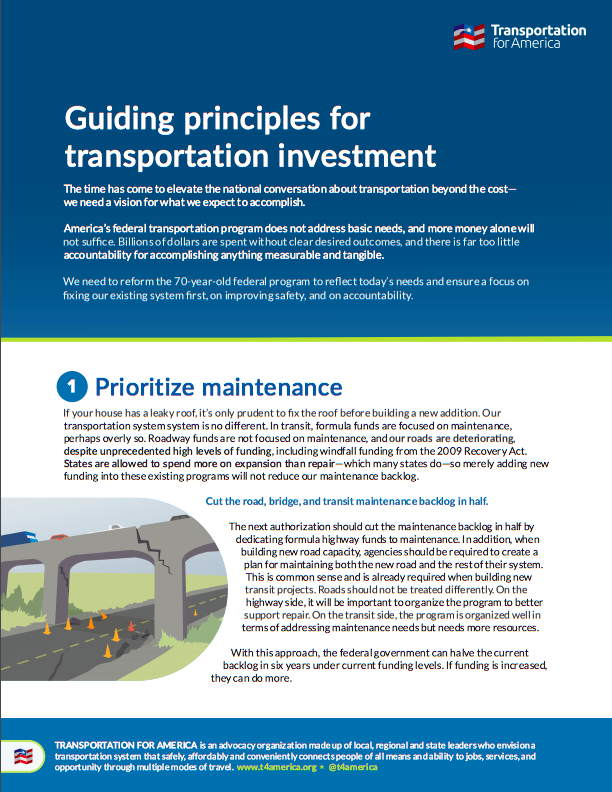How well does the House’s new transportation bill advance T4America’s core principles?
Federal transportation policy is in desperate need of an overhaul. This week, the House Transportation and Infrastructure Committee released a bill that makes substantial changes to connect the program to outcomes that Americans value. Here’s more on how the House bill starts to redirect transportation policy toward maintaining the current system, protecting the safety of people on the roads, and getting people to jobs, schools, groceries and health care.
House bill charts a course for updating country’s outdated transportation policy
The U.S. House Transportation & Infrastructure Committee (T&I) today released a draft proposal for long-term surface transportation policy to replace the existing FAST Act, which expires this year. The INVEST (Investing in a New Vision for the Environment and Surface Transportation) in America Act takes a markedly different approach to transportation policy that would begin to put outcomes—instead of price tags—at the center of our decision making.
New and expanded transit projects may not get built
City and state budget deficits and a drastic decline in transit ridership have pushed transit agencies to the brink of collapse. Communities that were on the verge of expanding or building new transit may not be able to finance their projects if Congress doesn’t act.
“Shovel-ready” projects just dig a deeper hole
Investing in “shovel-ready” projects—projects that are allegedly ready to go but just lacking funding—is an attractive idea for stimulating job growth. But as we learned in the 2009 stimulus, “shovel-ready” projects often aren’t all that shovel-ready, are frequently old road projects designed for the needs of the last century, fail to create jobs, and won’t help us build a safer, cleaner, and more equitable transportation system.
What do we do next? COVID-19 and the triple helix model of innovation
Where the triple helix may be most evident is how federal and state COVID-19 response guidelines affected government operations, educational institutions, and businesses.
Learning from COVID-19: Connecting with the research community
The research community is quickly engaging to help understand and evaluate responses to the COVID-19 pandemic. Practitioner and researcher collaboration will improve our understanding of what has worked and what has not, and how we might change our curbside in the longer term–whether for pandemic responses or for everyday operations in the coming “new normal.”
Over 160 sign letter in support of $32 billion for transit, but the fight isn’t over
Last week, the House of Representatives passed a COVID-19 relief bill that only included $15 billion in emergency support for public transportation. That’s not nearly enough; and it’s why over 160 organizations and elected officials signed our letter in support of $32 billion for transit on short notice. But we still need you to take action.
More than one million households without a car in rural America need better transit
Many people think the only Americans regularly relying on transit to reach jobs and services live in big cities. Yet the majority of counties with high rates of zero-car households are rural. In fact, more than one million households in predominantly rural counties do not have access to a vehicle. Rural Americans without cars face unique barriers and they deserve a tailored approach to their transit needs rather than just assuming they can or will drive everywhere.
House bill proposes $15 billion for transit. It’s not enough
Democrats in the House of Representatives only included $15 billion for transit in their next COVID-19 relief bill. That’s not enough—we need double that to ensure that transit survives this crisis. Send a message to your congressional delegation urging them to support $32 billion for transit.
Laser focused on repairing our bridges
Despite advances in technology, the standard practice for evaluating a bridge’s maintenance needs is a visual inspection, just as it was a half-century ago. To address our nation’s huge backlog in structurally deficient bridges in a more accurate and fiscally responsible way, the federal government should evaluate and speed the adoption of available technologies.











 This new guide, a collaboration between @T4…
This new guide, a collaboration between @T4…